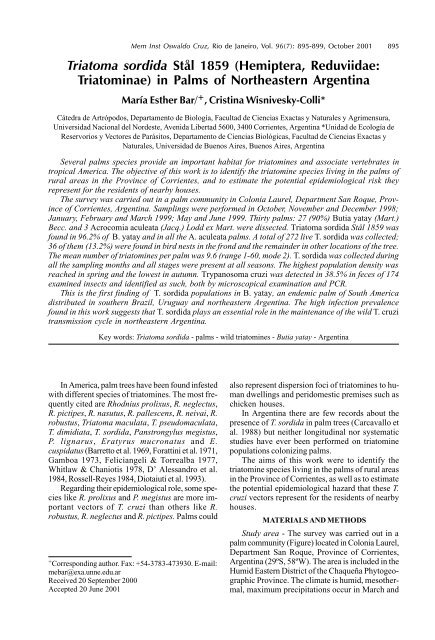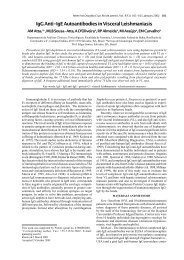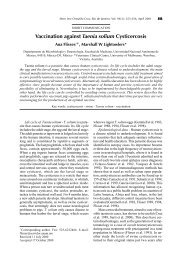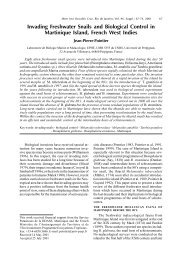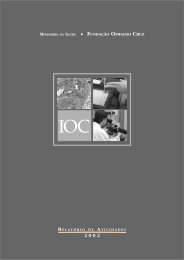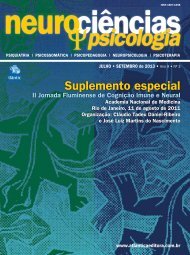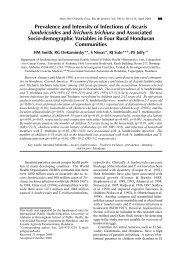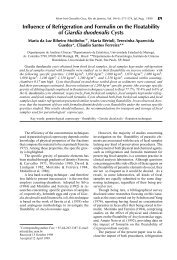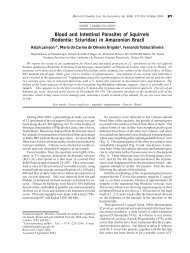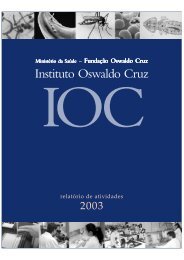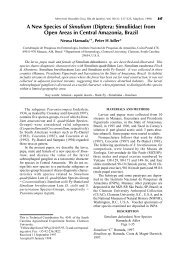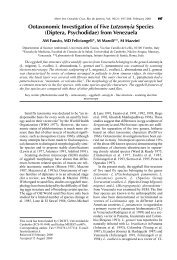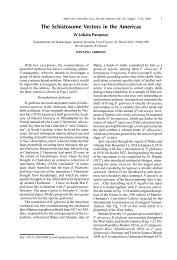in Palms of Northeastern Argentina - SciELO
in Palms of Northeastern Argentina - SciELO
in Palms of Northeastern Argentina - SciELO
You also want an ePaper? Increase the reach of your titles
YUMPU automatically turns print PDFs into web optimized ePapers that Google loves.
Mem Inst Oswaldo Cruz, Rio de Janeiro, Vol. 96(7): 895-899, October 2001<br />
Triatoma sordida Stål 1859 (Hemiptera, Reduviidae:<br />
Triatom<strong>in</strong>ae) <strong>in</strong> <strong>Palms</strong> <strong>of</strong> <strong>Northeastern</strong> Argent<strong>in</strong>a<br />
María Esther Bar/ + , Crist<strong>in</strong>a Wisnivesky-Colli*<br />
895<br />
Cátedra de Artrópodos, Departamento de Biología, Facultad de Ciencias Exactas y Naturales y Agrimensura,<br />
Universidad Nacional del Nordeste, Avenida Libertad 5600, 3400 Corrientes, Argent<strong>in</strong>a *Unidad de Ecología de<br />
Reservorios y Vectores de Parásitos, Departamento de Ciencias Biológicas, Facultad de Ciencias Exactas y<br />
Naturales, Universidad de Buenos Aires, Buenos Aires, Argent<strong>in</strong>a<br />
Several palms species provide an important habitat for triatom<strong>in</strong>es and associate vertebrates <strong>in</strong><br />
tropical America. The objective <strong>of</strong> this work is to identify the triatom<strong>in</strong>e species liv<strong>in</strong>g <strong>in</strong> the palms <strong>of</strong><br />
rural areas <strong>in</strong> the Prov<strong>in</strong>ce <strong>of</strong> Corrientes, and to estimate the potential epidemiological risk they<br />
represent for the residents <strong>of</strong> nearby houses.<br />
The survey was carried out <strong>in</strong> a palm community <strong>in</strong> Colonia Laurel, Department San Roque, Prov<strong>in</strong>ce<br />
<strong>of</strong> Corrientes, Argent<strong>in</strong>a. Sampl<strong>in</strong>gs were performed <strong>in</strong> October, November and December 1998;<br />
January, February and March 1999; May and June 1999. Thirty palms: 27 (90%) Butia yatay (Mart.)<br />
Becc. and 3 Acrocomia aculeata (Jacq.) Lodd ex Mart. were dissected. Triatoma sordida Stål 1859 was<br />
found <strong>in</strong> 96.2% <strong>of</strong> B. yatay and <strong>in</strong> all the A. aculeata palms. A total <strong>of</strong> 272 live T. sordida was collected;<br />
36 <strong>of</strong> them (13.2%) were found <strong>in</strong> bird nests <strong>in</strong> the frond and the rema<strong>in</strong>der <strong>in</strong> other locations <strong>of</strong> the tree.<br />
The mean number <strong>of</strong> triatom<strong>in</strong>es per palm was 9.6 (range 1-60, mode 2). T. sordida was collected dur<strong>in</strong>g<br />
all the sampl<strong>in</strong>g months and all stages were present at all seasons. The highest population density was<br />
reached <strong>in</strong> spr<strong>in</strong>g and the lowest <strong>in</strong> autumn. Trypanosoma cruzi was detected <strong>in</strong> 38.5% <strong>in</strong> feces <strong>of</strong> 174<br />
exam<strong>in</strong>ed <strong>in</strong>sects and identified as such, both by microscopical exam<strong>in</strong>ation and PCR.<br />
This is the first f<strong>in</strong>d<strong>in</strong>g <strong>of</strong> T. sordida populations <strong>in</strong> B. yatay, an endemic palm <strong>of</strong> South America<br />
distributed <strong>in</strong> southern Brazil, Uruguay and northeastern Argent<strong>in</strong>a. The high <strong>in</strong>fection prevalence<br />
found <strong>in</strong> this work suggests that T. sordida plays an essential role <strong>in</strong> the ma<strong>in</strong>tenance <strong>of</strong> the wild T. cruzi<br />
transmission cycle <strong>in</strong> northeastern Argent<strong>in</strong>a.<br />
Key words: Triatoma sordida - palms - wild triatom<strong>in</strong>es - Butia yatay - Argent<strong>in</strong>a<br />
In America, palm trees have been found <strong>in</strong>fested<br />
with different species <strong>of</strong> triatom<strong>in</strong>es. The most frequently<br />
cited are Rhodnius prolixus, R. neglectus,<br />
R. pictipes, R. nasutus, R. pallescens, R. neivai, R.<br />
robustus, Triatoma maculata, T. pseudomaculata,<br />
T. dimidiata, T. sordida, Panstrongylus megistus,<br />
P. lignarus, Eratyrus mucronatus and E.<br />
cuspidatus (Barretto et al. 1969, Foratt<strong>in</strong>i et al. 1971,<br />
Gamboa 1973, Feliciangeli & Torrealba 1977,<br />
Whitlaw & Chaniotis 1978, D’ Alessandro et al.<br />
1984, Rossell-Reyes 1984, Diotaiuti et al. 1993).<br />
Regard<strong>in</strong>g their epidemiological role, some species<br />
like R. prolixus and P. megistus are more important<br />
vectors <strong>of</strong> T. cruzi than others like R.<br />
robustus, R. neglectus and R. pictipes. <strong>Palms</strong> could<br />
+ Correspond<strong>in</strong>g author. Fax: +54-3783-473930. E-mail:<br />
mebar@exa.unne.edu.ar<br />
Received 20 September 2000<br />
Accepted 20 June 2001<br />
also represent dispersion foci <strong>of</strong> triatom<strong>in</strong>es to human<br />
dwell<strong>in</strong>gs and peridomestic premises such as<br />
chicken houses.<br />
In Argent<strong>in</strong>a there are few records about the<br />
presence <strong>of</strong> T. sordida <strong>in</strong> palm trees (Carcavallo et<br />
al. 1988) but neither longitud<strong>in</strong>al nor systematic<br />
studies have ever been performed on triatom<strong>in</strong>e<br />
populations coloniz<strong>in</strong>g palms.<br />
The aims <strong>of</strong> this work were to identify the<br />
triatom<strong>in</strong>e species liv<strong>in</strong>g <strong>in</strong> the palms <strong>of</strong> rural areas<br />
<strong>in</strong> the Prov<strong>in</strong>ce <strong>of</strong> Corrientes, as well as to estimate<br />
the potential epidemiological hazard that these T.<br />
cruzi vectors represent for the residents <strong>of</strong> nearby<br />
houses.<br />
MATERIALS AND METHODS<br />
Study area - The survey was carried out <strong>in</strong> a<br />
palm community (Figure) located <strong>in</strong> Colonia Laurel,<br />
Department San Roque, Prov<strong>in</strong>ce <strong>of</strong> Corrientes,<br />
Argent<strong>in</strong>a (29ºS, 58ºW). The area is <strong>in</strong>cluded <strong>in</strong> the<br />
Humid Eastern District <strong>of</strong> the Chaqueña Phytogeographic<br />
Prov<strong>in</strong>ce. The climate is humid, mesothermal,<br />
maximum precipitations occur <strong>in</strong> March and
896 T. sordida <strong>in</strong> <strong>Palms</strong> • ME Bar, C Wisnivesky-Colli<br />
General view <strong>of</strong> the palm community. First plane: Butia<br />
yatay Colonia Laurel, Department San Roque, Prov<strong>in</strong>ce <strong>of</strong><br />
Corrientes, Argent<strong>in</strong>a, 1998-1999<br />
November, while m<strong>in</strong>imum values are registered <strong>in</strong><br />
June and August (Duarte 1978/80). This area was<br />
selected by its typical sylvatic palms and the presence<br />
<strong>of</strong> nearby houses with permanent <strong>in</strong>habitants.<br />
Sampl<strong>in</strong>g design - Sampl<strong>in</strong>gs were carried out<br />
<strong>in</strong> October, November and December 1998 (spr<strong>in</strong>g);<br />
January, February and March 1999 (summer); May<br />
and June 1999 (autumn). In each sampl<strong>in</strong>g, four<br />
parallel transects <strong>of</strong> 300 m <strong>in</strong> length were placed, 50<br />
m apart from each other, leav<strong>in</strong>g approximately 25<br />
m between the palms and the nearby heterogeneous<br />
environments to avoid the border effect. A<br />
m<strong>in</strong>imum <strong>of</strong> four palms per month (one per transect)<br />
was selected at random to be dissected.<br />
Palm determ<strong>in</strong>ation and dissection - Palm species<br />
were taxonomically determ<strong>in</strong>ed us<strong>in</strong>g appropriate<br />
keys (Henderson et al. 1995). After cutt<strong>in</strong>g<br />
the palm at the base, it was put on a white cloth to<br />
facilitate the detection <strong>of</strong> escap<strong>in</strong>g <strong>in</strong>sects. Parts<br />
sprayed with tetramethr<strong>in</strong> 0.2% to dislodge bugs,<br />
and carefully exam<strong>in</strong>ed were as follows: the stipe,<br />
the axis <strong>of</strong> the frond bases, the petioles (<strong>in</strong>clud<strong>in</strong>g<br />
the broad ones <strong>of</strong> fallen dead leaves), the <strong>in</strong>ner<br />
spathe <strong>of</strong> the <strong>in</strong>florescence and the fibrous tissue<br />
that rema<strong>in</strong>s after sheath dis<strong>in</strong>tegration. The capture<br />
effort was estimated us<strong>in</strong>g the time spent by<br />
one person to <strong>in</strong>spect a palm (man/hour). Site data<br />
recorded <strong>in</strong>cluded: palm height and diameter, distance<br />
to the nearest dwell<strong>in</strong>g, and the location, if<br />
present, <strong>of</strong> bird nests, vertebrate, and their feces.<br />
Triatom<strong>in</strong>e collection - <strong>Palms</strong> were considered<br />
as <strong>in</strong>fected when any sign <strong>of</strong> triatom<strong>in</strong>e presence<br />
was found, such as dead or live nymphs and adults,<br />
eggs and exuviae. Collected triatom<strong>in</strong>es were put<br />
<strong>in</strong> properly labeled plastic jars with pleated filter<br />
paper and shipped immediately to our laboratory <strong>in</strong><br />
Corrientes.<br />
Laboratory studies - The taxonomic determ<strong>in</strong>ation<br />
<strong>of</strong> triatom<strong>in</strong>es was done us<strong>in</strong>g appropriate keys<br />
(Lent & Wygodz<strong>in</strong>sky 1979, Brewer et al. 1983). Insects<br />
were grouped accord<strong>in</strong>g to their developmental<br />
stage and sex and their number was recorded.<br />
The feces <strong>of</strong> triatom<strong>in</strong>es, obta<strong>in</strong>ed by abdom<strong>in</strong>al<br />
pressure, were diluted 1:1 <strong>in</strong> 0.85% sodium chloride<br />
solution and exam<strong>in</strong>ed microscopically at 400x<br />
for T. cruzi detection. T. cruzi identification was<br />
performed by morphological criteria (Barretto 1965)<br />
and the PCR technique. T. cruzi DNA was searched<br />
from dry triatom<strong>in</strong>e feces collected <strong>in</strong> Whatman no.<br />
1 paper by us<strong>in</strong>g the specific TCZ and Morel primers<br />
(Russomando et al. 1996).<br />
RESULTS<br />
Among the 30 palms that were dissected, 27<br />
(90%) were identified as Butia yatay (Mart.) Becc.<br />
and 3 (10%) as Acrocomia aculeata (Jacq.) Lodd<br />
ex Mart., both belong<strong>in</strong>g to the Subfamily<br />
Arecoidae. The mean length <strong>of</strong> palms was 5.82 m<br />
and the mean stipe diameter was 34 cm. The mean<br />
distance <strong>of</strong> palms to the nearest dwell<strong>in</strong>g was 190.7<br />
m, rang<strong>in</strong>g from 1,000 to 50 m. The mean time <strong>of</strong><br />
dissection per palm was 2 h (range: 0.55-3 h) and<br />
the total capture effort was 8 m/h per palm.<br />
Bird nests were present <strong>in</strong> 26.7% (8/30) palms<br />
and half <strong>of</strong> them (4/8) belonged to the Furnariidae<br />
family.<br />
Evidences <strong>of</strong> the presence <strong>of</strong> mammals were<br />
recorded <strong>in</strong> 20% (6/30) palms. Those were: opossum<br />
<strong>in</strong>dividuals (Didelphis albiventris), their nests<br />
and feces and/or rodent scats.<br />
The follow<strong>in</strong>g triatom<strong>in</strong>e species were identified<br />
<strong>in</strong> B. yatay: T. sordida, T. platensis Neiva 1913<br />
and Psammolestes coreodes Bergroth 1911. T.<br />
sordida was the only species found <strong>in</strong> A. aculeata.<br />
In one bird nest built on a B. yatay palm we<br />
found 16 T. sordida, 2 first stage nymphs <strong>of</strong> T.<br />
platensis and 4 fifth stage nymphs <strong>of</strong> P. coreodes.<br />
T. sordida was found <strong>in</strong> 96.2% B. yatay and <strong>in</strong><br />
all the dissected A. aculeata.
Mem Inst Oswaldo Cruz, Rio de Janeiro, Vol. 96(7), October 2001<br />
897<br />
Table I shows the density and the <strong>in</strong>festation<br />
<strong>in</strong>dexes <strong>of</strong> triatom<strong>in</strong>es <strong>in</strong> palms, as well as relative<br />
abundance <strong>of</strong> nymphs and adults, along the seasons.<br />
Most <strong>of</strong> the palms (80%) were exclusively <strong>in</strong>fested<br />
by T. sordida nymphs, followed by 13.3%<br />
palms with nymphs and adults and one palm harbor<strong>in</strong>g<br />
only adults.<br />
The whole T. sordida population collected was<br />
272 live specimens; 36 <strong>of</strong> them (13.2%) were found<br />
<strong>in</strong> bird nests located <strong>in</strong> the palm frond, and the<br />
rema<strong>in</strong>der <strong>in</strong> the axis <strong>of</strong> the frond and other hid<strong>in</strong>g<br />
places spread over the tree. The number <strong>of</strong><br />
triatom<strong>in</strong>es per palm ranged between 1 and 60 <strong>in</strong>dividuals<br />
(mean 9.6; mode 2).<br />
T. cruzi <strong>in</strong>fection - Sixty-seven T. sordida out<br />
<strong>of</strong> 174 (38.5%) exam<strong>in</strong>ed <strong>in</strong>sects showed trypanosomes<br />
<strong>in</strong> feces. Their identity as T. cruzi was subsequently<br />
confirmed by PCR. Infection rate <strong>in</strong>creased<br />
l<strong>in</strong>early with age (regression l<strong>in</strong>e: y = 13,8x-<br />
25,4, R 2 = 0.9894) (Table II). Detailed results on T.<br />
cruzi <strong>in</strong>fection detected by PCR will be published<br />
separately.<br />
TABLE I<br />
Seasonal <strong>in</strong>festation <strong>in</strong>dex, density <strong>in</strong>dex and relative<br />
abundance <strong>of</strong> Triatoma sordida, T. platensis and<br />
Psammolestes coreodes <strong>in</strong> palms, 1998-1999, Colonia<br />
Laurel, Department San Roque, Prov<strong>in</strong>ce <strong>of</strong><br />
Corrientes, Argent<strong>in</strong>a<br />
Variables Spr<strong>in</strong>g Summer Fall Total<br />
No. <strong>of</strong> dissected palms 13 11 6 30<br />
No. <strong>of</strong> <strong>in</strong>fested palms 13 10 6 20<br />
Infestation Index a 100 90 100 96.7<br />
Density Index b 12 6.7 9 9.6<br />
Total no. <strong>of</strong> nymphs<br />
and eggs collected 151 c 67 c,d 54 272<br />
Total no. <strong>of</strong> adults<br />
collected 6 0 0 6<br />
a: no. <strong>of</strong> positive palms/no. <strong>of</strong> exam<strong>in</strong>ed palms; b: no. <strong>of</strong><br />
collected triatom<strong>in</strong>es/no. <strong>of</strong> positive palms; c: one T.<br />
sordida egg; d: two first stage nymphs <strong>of</strong> T. platensis<br />
and 4 fifth stage nymphs <strong>of</strong> P. coreodes<br />
DISCUSSION<br />
This work represents the first longitud<strong>in</strong>al study<br />
published <strong>in</strong> Argent<strong>in</strong>a about triatom<strong>in</strong>e <strong>in</strong>festation<br />
<strong>in</strong> palms.<br />
T. sordida was the dom<strong>in</strong>ant species collected<br />
<strong>in</strong> B. yatay compared with T. platensis and P.<br />
coreodes. This result constitutes the first f<strong>in</strong>d<strong>in</strong>g<br />
<strong>of</strong> T. sordida <strong>in</strong> the mentioned palm species, which<br />
is endemic <strong>of</strong> South America and has exclusively<br />
been cited for Argent<strong>in</strong>a, Uruguay and State <strong>of</strong><br />
Rio Grande do Sul <strong>in</strong> Brazil (Henderson et al. 1995).<br />
TABLE II<br />
Trypanosoma cruzi <strong>in</strong>fection <strong>in</strong> Triatoma sordida<br />
developmental stages, Colonia Laurel, Department San<br />
Roque, Prov<strong>in</strong>ce <strong>of</strong> Corrientes, Argent<strong>in</strong>a<br />
Stage No. No. (%) No. (%)<br />
collected exam<strong>in</strong>ed <strong>in</strong>fected<br />
N1 23 4 (17) 0 (0)<br />
N2 48 22 (46) 4 (18)<br />
N3 72 44 (61) 13 (30)<br />
N4 74 61 (82) 28 (46)<br />
N5 48 40 (83) 22 (55)<br />
Adults 6 3 0 (0)<br />
Total 271 174 (64) 67 (38.5)<br />
The high <strong>in</strong>festation <strong>in</strong>dexes we found <strong>in</strong> B.<br />
yatay are similar to those reported for other ensembles<br />
<strong>of</strong> palms and triatom<strong>in</strong>es. Thus, R.<br />
neglectus and R. prolixus were collected <strong>in</strong> 95 and<br />
92% <strong>of</strong> exam<strong>in</strong>ed Orbignya martiana, respectively<br />
(Bento et al. 1984, D’Alessandro et al. 1984).<br />
On the other hand, the presence <strong>of</strong> different<br />
triatom<strong>in</strong>e species <strong>in</strong> one s<strong>in</strong>gle palm is a common<br />
fact and usually one <strong>of</strong> them is dom<strong>in</strong>ant due to its<br />
frequency and relative abundance. Tonn et al. (1976)<br />
confirmed that 75.1% Acrocomia sp. was <strong>in</strong>fected<br />
by five triatom<strong>in</strong>e species <strong>of</strong> the follow<strong>in</strong>g genus:<br />
Eratyrus, Panstrongylus, Rhodnius, and Triatoma.<br />
Feliciangeli and Torrealba (1977) cited R. prolixus<br />
as the most abundant <strong>in</strong> Copernicia tectorum, coexist<strong>in</strong>g<br />
with T. maculata <strong>in</strong> 3.8% palms. Whitlaw<br />
and Chanotis (1978) reported the simultaneous presence<br />
<strong>of</strong> R. pallescens and T. dimidiata, <strong>in</strong> 91% <strong>of</strong><br />
Scheelea zonensis palms, although the first species<br />
was clearly dom<strong>in</strong>ant.<br />
In the present work, all dissected A. aculeata<br />
were exclusively colonized by T. sordida. In Brazil,<br />
the synonyms species A. sclerocarpa was mostly<br />
<strong>in</strong>fested by R. neglectus and secondarily by T.<br />
sordida and P. megistus (Barretto et al. 1969,<br />
Diotaiuti & Dias 1984).<br />
In Uberaba, State <strong>of</strong> M<strong>in</strong>as Gerais, Barretto et<br />
al. (1969) dissected 232 palms <strong>of</strong> six different species<br />
and collected 949 specimens <strong>of</strong> T. sordida. Infestations<br />
recorded (from 17.6 to 50%) were lower<br />
than those found <strong>in</strong> our work. In addition to the<br />
mean number <strong>of</strong> <strong>in</strong>sects per palm, which ranged<br />
between 2.1 and 8.3 triatom<strong>in</strong>es, was similar to the<br />
densities found <strong>in</strong> B. yatay.<br />
Besides, the only habitat recorded for R. brethesi<br />
was Leopold<strong>in</strong>ia piassava <strong>in</strong> the Rio Negro, region<br />
<strong>of</strong> Barcelos, Amazonas (Mascarenhas 1991).<br />
This author collected <strong>in</strong> Urumutum a mean number<br />
<strong>of</strong> 5.04 <strong>in</strong>sects per palm and 1.1 <strong>in</strong> Rilau, these den-
898 T. sordida <strong>in</strong> <strong>Palms</strong> • ME Bar, C Wisnivesky-Colli<br />
sities were lower than the registered <strong>in</strong> the present<br />
<strong>in</strong>vestigation.<br />
We collected T. sordida <strong>in</strong> all sampled months.<br />
The highest population density was reached <strong>in</strong><br />
spr<strong>in</strong>g and the lowest <strong>in</strong> autumn. The adult presence<br />
might have been underestimated s<strong>in</strong>ce males<br />
and females fly to colonize new biotopes. It is worth<br />
<strong>of</strong> mention<strong>in</strong>g that all <strong>in</strong>star nymphs were present<br />
dur<strong>in</strong>g the three sampl<strong>in</strong>g seasons, suggest<strong>in</strong>g that<br />
younger stages endure w<strong>in</strong>ter conditions, a situation<br />
which has not been observed for other wild<br />
triatom<strong>in</strong>e species <strong>in</strong> Northern Argent<strong>in</strong>a<br />
(Wisnivesky-Colli 1994).<br />
Our results <strong>in</strong>dicate that palms represent an<br />
advantageous habitat for T. sordida because they<br />
provide refuge to potential feed<strong>in</strong>g sources such<br />
as birds, amphibians, bats, opossums, rodents and<br />
reptiles. Besides, adequate microclimatic conditions<br />
<strong>in</strong> those places where triatom<strong>in</strong>es shelter might<br />
buffer the high summer temperatures, as it was<br />
shown for palms from Venezuela (Pifano 1973,<br />
Rossell-Reyes 1984).<br />
The proportion <strong>of</strong> T. sordida <strong>in</strong>fected by T. cruzi<br />
(38.5%) was higher than rates obta<strong>in</strong>ed by Barretto<br />
et al. (1969) for T. sordida <strong>in</strong> three palm species<br />
(15.3%), although he found a prevalence <strong>of</strong> 29.3%<br />
for those specimens collected from Orbignya<br />
martiana.<br />
Among the few T. platensis and P. coreodes<br />
caught by us <strong>in</strong> bird nests, no T. cruzi <strong>in</strong>fection<br />
was detected, possibly due to the fact that those<br />
<strong>in</strong>sects had fed on bird.<br />
Most <strong>of</strong> the <strong>in</strong>fected triatom<strong>in</strong>es were found <strong>in</strong><br />
those palms where the presence <strong>of</strong> Didelphis<br />
albiventris and rodent feces was recorded. This<br />
result is <strong>in</strong> agreement with Barretto et al. (1969) and<br />
Monteiro et al. (1999) who consider opossums and<br />
rodents as T. cruzi reservoirs <strong>in</strong> palms.<br />
The high <strong>in</strong>fection prevalence found <strong>in</strong> this<br />
work suggests that T. sordida plays an essential<br />
role <strong>in</strong> the ma<strong>in</strong>tenance <strong>of</strong> the wild transmission<br />
cycle <strong>in</strong> northeastern Argent<strong>in</strong>a. On the other hand,<br />
leaves, bark and fruits from palms are frequently<br />
used by rural <strong>in</strong>habitants, giv<strong>in</strong>g rise to an important<br />
risk <strong>of</strong> transmission to humans. In particular,<br />
fronds and stipes are used <strong>in</strong> walls and ro<strong>of</strong>s <strong>of</strong><br />
houses, favor<strong>in</strong>g the passive transport <strong>of</strong> wild<br />
triatom<strong>in</strong>es to the domestic environment, as po<strong>in</strong>ted<br />
out by Gamboa (1973) and Pifano (1973) for R.<br />
prolixus <strong>in</strong> Venezuela.<br />
Further studies are needed to evaluate the actual<br />
risk that palm T. sordida populations represent<br />
for the <strong>in</strong>habitants <strong>of</strong> nearby houses.<br />
ACKNOWLEDGMENTS<br />
To E Oscherov, M Damborsky, M Alvarez, G<br />
Avalos, H Presmann for their assistance on the field and<br />
laboratory work. To J Vargas for his valuable help and to<br />
S Pîetrokovsky for the English version <strong>of</strong> the manuscript.<br />
REFERENCES<br />
Barreto MP 1965. Tripanossomos semelhantes ao Trypanosoma<br />
cruzi em animais silvestres e sua<br />
identificaçao com o agente etiológico da doença de<br />
Chagas. Rev Inst Med Trop São Paulo 7: 304-315.<br />
Barretto MP, Albuquerque RDR, Funayama GK 1969.<br />
Estudos sôbre reservatórios e vetores silvestres do<br />
“Trypanosoma cruzi”. XXXVI: <strong>in</strong>vestigações sôbre<br />
triatomíneos de palmeiras no município de Uberaba,<br />
MG, Brasil. Rev Bras Biol 29: 577-588.<br />
Bento DNC, Branco AZCL, Freitas MR, P<strong>in</strong>to AS 1984.<br />
Epidemiologic studies <strong>of</strong> Chagas’ disease <strong>in</strong> the urban<br />
zone <strong>of</strong> Teres<strong>in</strong>a, State <strong>of</strong> Piauí, <strong>Northeastern</strong><br />
Brasil. Rev Soc Bras Med Trop 17: 199-203.<br />
Brewer M, Garay M, Gorla D, Murua F, Favot R 1983.<br />
Caracterización de los estadios n<strong>in</strong>fales del género<br />
Triatoma Laporte 1833. II. Triatoma platensis Neiva<br />
1913, Triatoma delpontei Romaña y Ábalos 1947,<br />
Triatoma sordida Stål 1859. (Hemiptera, Reduviidae).<br />
Rev Soc Entomol Argent 42: 219-241.<br />
Carcavallo RU, Canale DM, Martínez A 1988. Habitats<br />
de triatom<strong>in</strong>os argent<strong>in</strong>os y zonas ecológicas donde<br />
prevalecen. Chagas 5: 8-17.<br />
D’Alessandro A, Barreto P, Saravia N, Barreto M 1984.<br />
Epidemiology <strong>of</strong> Trypanosoma cruzi <strong>in</strong> the oriental<br />
pla<strong>in</strong>s <strong>of</strong> Colombia. Am J Trop Med Hyg 33: 1084-<br />
1095.<br />
Diotaiuti L, Dias JCP 1984. Ocorrência e biologia do<br />
Rhodnius neglectus Lent 1954 em macaubeiras da<br />
periferia de Belo Horizonte, M<strong>in</strong>as Gerais. Mem Inst<br />
Oswaldo Cruz 79: 293-301.<br />
Diotaiuti L, Loiola CF, Falcão PL, Dias JCP 1993. The<br />
ecology <strong>of</strong> Triatoma sordida <strong>in</strong> natural environments<br />
<strong>in</strong> two different regions <strong>of</strong> the State <strong>of</strong> M<strong>in</strong>as Gerais,<br />
Brazil. Rev Inst Med Trop São Paulo 35: 237-245.<br />
Duarte LA 1978/80. L<strong>in</strong>eamientos para las Políticas de<br />
Desarrollo Urbano de la Prov<strong>in</strong>cia de Corrientes,<br />
Secretaría de Estado Desarrollo Urbano y Vivienda,<br />
Corrientes, Argent<strong>in</strong>a.<br />
Feliciangeli PD, Torrealba JW 1977. Observaciones sobre<br />
Rhodnius prolixus (Hemiptera, Reduviidae) en su<br />
biotopo silvestre Copernicia tectorum. Bol Dir<br />
Malariol Saneam Ambien 17: 198-205.<br />
Foratt<strong>in</strong>i OP, Ferreira OA, da Rocha e Silva EO, Rabello<br />
EX, Santos JLF 1971. Aspectos ecológicos da<br />
tripanossomose Americana. II. Distribuição e<br />
dispersão local de triatomíneos em ecótopos naturais<br />
e artificiais. Rev Saúde Púb São Paulo 5: 163-191.<br />
Gamboa JC 1973. La población silvestre de Rhodnius<br />
prolixus en Venezuela. Arch Venez Med Trop Parasit<br />
Med 5: 321-352.<br />
Henderson A, Galeano G, Bernal R. 1995. Field Guide to<br />
the <strong>Palms</strong> <strong>of</strong> the Americas, Pr<strong>in</strong>ceton University<br />
Press, New Jersey, 352 pp.<br />
Lent H, Wygodz<strong>in</strong>sky P 1979. Revision <strong>of</strong> the<br />
Triatom<strong>in</strong>ae (Hemiptera, Reduviidae) and their significance<br />
as vectors <strong>of</strong> Chagas’ disease. Bull Am Mus<br />
Nat History 163: 123-520.
Mem Inst Oswaldo Cruz, Rio de Janeiro, Vol. 96(7), October 2001<br />
899<br />
Mascarenhas B M, 1991. Triatomíneos da Amazônia:<br />
sobre o habitat e algumas considerações comportamentais<br />
de Rhodnius brethesi Matta, 1919 (Hemiptera:<br />
Reduviidae: Triatom<strong>in</strong>ae) na Região do Médio<br />
Rio Negro, Amazonas. Bol Mus Para Emilio Goeldi,<br />
sér Zool 7: 107-116.<br />
Monteiro PS, Rebelo JMM, Costa JML, Nascimento<br />
RJ, Teixeira ARL 1999. Cadeia trófica e ciclo de<br />
transmissão do Trypanosoma cruzi em palmeiras<br />
Orbignya phalerata. Rev Soc Bras Med Trop 32<br />
(Supl. II): 123.<br />
Pifano FC 1973. La d<strong>in</strong>ámica epidemiológica de la<br />
enfermedad de Chagas en el Valle de los Naranjos,<br />
Estado de Carabobo, Venezuela. I. Contribución al<br />
estudio de los focos naturales silvestres del<br />
Schizotripanum cruzi Chagas 1909. Arch Venez Med<br />
Trop Parasitol Med 5: 1-29.<br />
Rossell-Reyes O 1984. A Comparison <strong>of</strong> the Feed<strong>in</strong>g<br />
Performances <strong>of</strong> Rhodnius prolixus Stål and Rhodnius<br />
robustus Larrousse (Hemiptera: Triatom<strong>in</strong>ae), PhD<br />
Thesis, University <strong>of</strong> London, 339 pp.<br />
Russomando G, Rojas de Arias A, Almirón M, Figueredo<br />
A, Ferreira ME, Morita K 1996. Trypanosoma cruzi:<br />
polymerase cha<strong>in</strong> reaction-based detection <strong>in</strong> dried<br />
feces <strong>of</strong> Triatoma <strong>in</strong>festans. Exp Parasitol 83: 62-66.<br />
Tonn RJ, Carcavallo RU, Ortega R, Carrasquero B 1976.<br />
Métodos de estudio de triatom<strong>in</strong>os en el medio<br />
silvestre. Bol Dir Malariol Saneam Ambien 16: 146-<br />
152.<br />
Whitlaw JT, Chaniotis BN 1978. Palm trees and Chagas’<br />
disease <strong>in</strong> Panamá. Am J Trop Med Hyg 27: 873-881.<br />
WHO-World Health Organization 1991. Control <strong>of</strong><br />
Chagas Disease, WHO Technical Report Series 811,<br />
95 pp.<br />
Wisnivesky-Colli C 1994. Triatom<strong>in</strong>os vectores<br />
secundarios del Trypanosoma cruzi, su domiciliación<br />
potencial, Thesis, Universidad de los Andes, Mérida,<br />
Venezuela, p. 83-92.
900 T. sordida <strong>in</strong> <strong>Palms</strong> • ME Bar, C Wisnivesky-Colli


